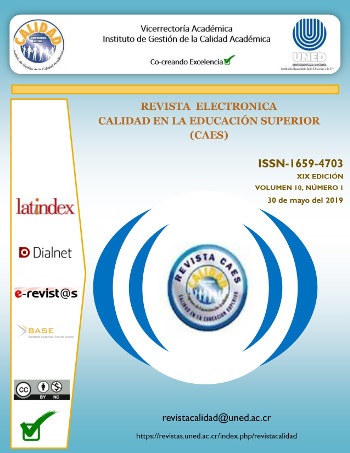Are metaphor and metonymy useful contents for teaching-learning process on proofreading?
DOI:
https://doi.org/10.22458/caes.v10i1.2476Keywords:
: university didactics, teaching-learning, metaphor, metonymy, proofreadingAbstract
Due to the need of giving a class on metaphor and metonymy in a diplomacy about proofreading, it arose the question of the degree of pedagogical usefulness for this particular issue. In this article, it will be explained why teaching metaphor and metonymy in the field of proofreading can be useful. A particular case of adaptation of this subject will be presented, which took place in a class for a diplomacy about proofreading in Mendoza, Argentina, in 2018. Finally, findings of this experience will be collected and some considerations will be made on pedagogical implications of the inclusion of metaphor and metonymy in the curriculum about proofreading. It is concluded that metaphor and metonymy position themselves, indeed, as very useful notions in the field of proofreading teaching, mainly because they increase student’s motivation and provide significance to classes. Conclusions will be close with the projection of a future investigation that continues along the lines discussed in this article.
References
Black, M. (1954-1955). “Metaphor”. Proceedings of the Aristotelian Society, 55, 273-294.
Chango más (página web). En línea: https://www.changomas.com.ar/ (Consulta: 20/10/18).
Crespo Fernández, E. (2008), “La conceptualización metafórica del eufemismo en epitafios”, Estudios Filológicos, 43, pp. 83-100
Derrida, J. (1997). “La Retirada de la Metáfora”. En: La Deconstrucción en las Fronteras de la Filosofía. Barcelona: Paidós. Disponible en: http://www.ddooss.org/articulos/textos/derrida_metafora.pdf [Consulta: 09/09/2015].
Fauconnier, G. (1984). Espaces mentaux. Aspects de la construction du sens dans les langues naturelles. Paris: Minuit.
Fauconnier, G.; Turner, M. (1998). “Mental Spaces”. Reeditado en: D. Geeraerts (ed.) (2006), Cognitive Linguistics: Basic Readings, Berlín: Mouton de Gruyter.
Fauconnier, G.; Turner, M. (2002). The Way We Think. Conceptual Blending and the Mind’s Hidden Complexities. New York: Basics Books.
Gonzalez, D. (2016). La Lingüística Cognitiva y su teorización sobre la metáfora conceptual: Principales visiones históricas sobre el fenómeno y caracterización desde los principios cognitivo-funcionales. Düsseldorf: Editorial Académica Española.
Gonzalez, D. (2018a). El cuerpo en la Lingüística Cognitiva: la metáfora conceptual y el embodiment. Correspondencias & Análisis, 7, 187-195. ISSN impreso: 2224-235X; ISSN en línea: 2304-2265. DOI: https://doi.org/10.24265/cian.2017.n7.11 [Consulta: 10/01/2018].
Gonzalez, D. (ed.) (2018b). Análisis interdisciplinar de objetos culturales sobre problemáticas sociales. München: GRIN.
Goossens, L. (1990). Metaphtonymy: the Interaction of Metaphor and Metonymy in Expressions for Linguistic Action. Cognitive Linguistics, I(3), 323-340.
Johnson, M. (1987). The Body in the Mind: The Bodily Basis of Meaning, Imagination, and Reason. Chicago: University of Chicago Press.
Kirby, J. (1997). “Aristotle on Metaphor”. The American Journal of Philology, 4(118), 517-554.
Kövecses, Z. (2010). Metaphor: A Practical Introduction, 2ª ed., Oxford: Oxford University Press.
Lakoff, G.; Johnson, M. (1980). Metaphors we live by. Chicago: University of Chicago Press.
Lausberg, H. (1967 [1960]). Manual de retórica literaria. Fundamentos de una ciencia literaria, Tomo II, Trad. J. Pérez Riesco, Madrid: Gredos.
Lucas_kissmeonce (2018). Cuando hacés patys a la plancha sin tener extractor de cocina (imagen de deskgram). Recuperado de: https://deskgram.net/p/1755627067134480706_2876666499 (Consulta: 30/05/19).
MaCristina 2019, el tatuaje que busca terminar con la grieta (28 de agosto de 2018). Radio Mitre. En línea: https://radiomitre.cienradios.com/macristina-2019-tatuaje-busca-terminar-la-grieta/ (Consulta: 20/10/18).
Real Academia Española, Asociación de Academias de la Lengua Española. (2014). Diccionario de la lengua española, 23ª ed., Madrid: Espasa. Disponible en: http://dle.rae.es/ [Consulta: 10/10/2018].
Ricoeur, P. (1980 [1975]). La metáfora viva, Trad. A. Neira, Madrid: Ediciones Europa.
Ullmann, S. (1987). Significado y estilo. Madrid, Aguilar.
Downloads
Published
How to Cite
Issue
Section
License
Esta revista provee acceso libre inmediato a su contenido bajo el principio de que hacer disponible gratuitamente la investigación al publico, lo cual fomenta un mayor intercambio de conocimiento global.
